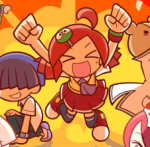Please no door repair rooms... those discourage exploration, not encourage it. Would you want to be penalized for playing the game like you're meant to?
I agree with this, 103%. I've told more than my fair share of questmakers, that door repair rooms discourage exploration, and are hateful enough that any sensible person is likely to stop playing the game; particularly when they siphon > 50 rupees.
What I do, if you're curious, is a two-part situation.
People Will Always Grind
In place of a normal rupee cap, I set up a capacity system. That meaning, every small object in the game, has a fixed size. The value of the object, and its size, are independent. Thus, I can set up items (let's call them size small, medium, and large) with sizes 1, 3, and 5 respectively, that can be of any monetary value.
If you'd like, I'll supply both the code, and a list, for making this work (it's in RPG.zh and works out of the box).
Object Sizes and Reward Value
The basic idea, is that I have a table of this sort:
Object Value Size Rarity
Coin 1 1 1 - Grinding, Enemies, common
Coin 5 3 1 - Grinding, Enemies, common
Coin 10 5 1 - Grinding, Enemies, common
Coin 25 1 3 - Grinding, Enemies uncommon
Coin 50 3 4 - Grinding (rare), Enemies (uncommon)
Coin 100 5 5 - Grinding (very rare), Enemies (rare)
Coin 100 1 6 - Grinding (never), Enemies (scarce), Treasure (common)
Coin 250 3 7 - Grinding (never), Enemies (rare), Treasure (common)
Coin 500 5 7 - Grinding (never), Enemies (rare), Treasure (uncommon)
Gem 250 1 8 - Grinding (never), Enemies (tougher only), Treasure (uncommon)
Gem 500 1 9 - Grinding (never), Enemies (very rare), Treasure (rare, sidequest, or special)
Gem 1000 1 10 - Grinding (never), Enemies (bosses), Treasure (side-quest only)
For clarity, coins are different metals, and different sizes. Low value coins, through reasonably high value coins (of large physical size) may be obtained by grinding, or from fighting normal enemies, but this quickly fills up the available 'free space', whilst giving a relatively low value for the space it's filling.
If the player is out of free space, then they can;t collect any more money objects, and need to either go to a moneychanger (e.g. bank, or shopkeep) to trade up. A moneychanger charges a fixed price, while a storekeep will change up a percentage of their space, based on how much they buy. (Read: Buying an item reduces used space by a % based on its cost.)
What This Does
It allows a player to grind, if they wish to grind, but it makes grinding less profitable, because they can't find high-value, small items, or very-high-value items. That, with the added bonus of trekking back to change in their money, means that grinding becomes more tedious.
The Reward Factor
Now, that's all well-and-good, but how should a [good] player seek monetary rewards? Here's my list:
In-Dungeon Treasure.
These rewards should be given for solving puzzles, or beating tough enemies. The amount of space used by the money object, compared to its monetary value, makes it appealing, but these shouldn't be far better than what a player can ordinarily get, because they are found along the normal route of the game.
Exploration Rewards
Secret finds, are a better source of good treasure. Rather than a 100 rupee object that eats up '100' space, the player can find objects worth 100, 250, or more, that eat up only '1', '3', or '5' space. This is usually going to require a player both to explore, and to pay attention; be that to visual clues, or hints given in the game, and may require some backtracking. The more backtracking, the greater the reward. It's wise to make these awards appear in mini-dungeons, with more than one single award. Put two, or three awards in an optional mini-dungeon, and you'll liven up the play, and enjoyability of going to find them.
Antiquities
Very rare items, should require puzzle solving. I don;t mean block puzzles, but logical puzzles: Patching together hints, and clues. It's good to place quest items (upgrades to equipment) and a rare gem, or two, or some money awards that use little space, in their own mini-dungeon, cave, or hidden spot. These should feel like a proper side-quest, not merely exploration.
Drops from Mid-Bosses
Another good way to dole out valuable coins, gems, or other money objects, is to have mid-bosses drop them; or to have tough enemies drop a chest (open for random reward; you can randomise those drops, with the code that I have).
Changes, With a Size System
Obviously, this works when you implement a size system. It's pretty easy, and I could package it for anyone as a standalone module. It replaces the quantity of rupees wallets, with something a bit different. Wallets under this system add to carrying capacity (space), rather than value, and the max capacity (value) is usually unlimited. This also allows setting far higher prices, to make finding those rewards more desirable.
You can put game items, that are potentially optional, or hard to find, in stores, at very high prices, and a player could actually buy them, but only if they complete side-quests to gain the needed riches. As an example, if you put the blue ring in a shoppe, you could set the price at 2,000 without batting an eye. You could put that in a mid-difficulty dungeon as a free item, and at the same time, have it in a shoppe, that the player could buy, if he does two or three less difficult mini-dungeons. This allows for a more mixed, non-linear order of gameplay.
------
Without a Size System
If you forego a size system as described above, all is not lost. One thing you will want to do, is add a tiny script that allows wallets > 999 rupees. (I will supply that, if desired). Then, tack that onto wallets that they player may buy, or only find through exploration; and make objects that are worth buying at large values, available.
With this formula, you need to make finding 100+ sized rupees interesting. put them in treasure chests, and work with high-value rewards as above. The problem, is that a player who's a determined grinder can just ignore the side quests, which is why making wallets that go up to at least 5,000 (or 9,999) into side-quest items. This is how to make high-value rupee counts worth more; by making expensive things, truly expensive, and making them desirable.
How to Make Small Rupee Counts More Valuable
Reduce, or eliminate ammo drops, from most enemies. If a player needs to restock, they'll need to buy supplies. This works best, if you don;t over-limit their item counters. Set bombs at 20, and Arrows at 50, as a starting value for each, so that running out accidentally is less of a threat.
If you have a boss, or something in a dungeon that requires a counter item, you can put it close to their lair as a freebie, but otherwise, make the player buy things. Reducing the drop rate of rupees is also a god idea. Make the drop rate for slash combos very low, for monetary items; and reasonable for health. If an enemy is very weak (easy to kill), give him heart, and magic drops, but no money.
These things combined, will make small values more valuable, because (1) it is harder to obtain money, and (2) money is necessary to buy supplies.
No Rupoors
I file these under the same level of hatefulness as door repairs, except that they're also random. Don't punish the player with bad RNG like that. I'd rather play a game with no money drops, than run into Rupoor drops when trying to frantically restore HP.
Imagine Door Repair room that just empties you wallet completely somewhere in the Dark World...
That's probably the only interesting take on door repairs that I've ever seen mentioned. If the player can re-obtain what is stolen, it's less of a bitter pill. I'm still against them in general, but that could be interesting, if done right.
I find that a screen with lots of destructible stuff (tall grass, pots, etc.) will net you more rupees than grinding enemies, usually. I threw a black Rupoor (-10) into the item dropset to keep it interesting- it keeps the player from just blindly picking up everything they happen to find. A room full of grass that leaves behind bare dirt that can be further affected by a Shovel... a person with just a little patience can make bank.
[ ... ]
Have you actually playtested many games that do that? Guess wht? That becomes the only thing about the game that people remember; and they remember that they hate it. It's bad enough that you might grab one when you're franric for hearts; but the fact that you need to skirt by them, and go out of your way to painstakingly avoid them, is simply tedious. it isn't fun in the least, and because you can usually collect them with a sword, or other weapons, you can pick them up when fighting, and have no chance to avoid them.
Also, don't forget to pepper in 'It's a Secret to Everyone' rooms here and there... but also 'Pay me for the Door Repairs' rooms, too. It adds a level of exploration and risk and gives the player a reason to stay on a screen longer than the time it takes to run across it.
Actually, it boils down to not wanting to open anything: It's not a risk/reward situation. The player simply doesn't want to open anything up, because it's not worth it. If you want risk/reward, put a money making game in each spot where you'd have either free money, or door repairs; and see if anyone bothers to play it. (Hint: They won't, but they'll grumble about their wasted bomb.)
Edited by ZoriaRPG, 08 June 2015 - 09:27 AM.














